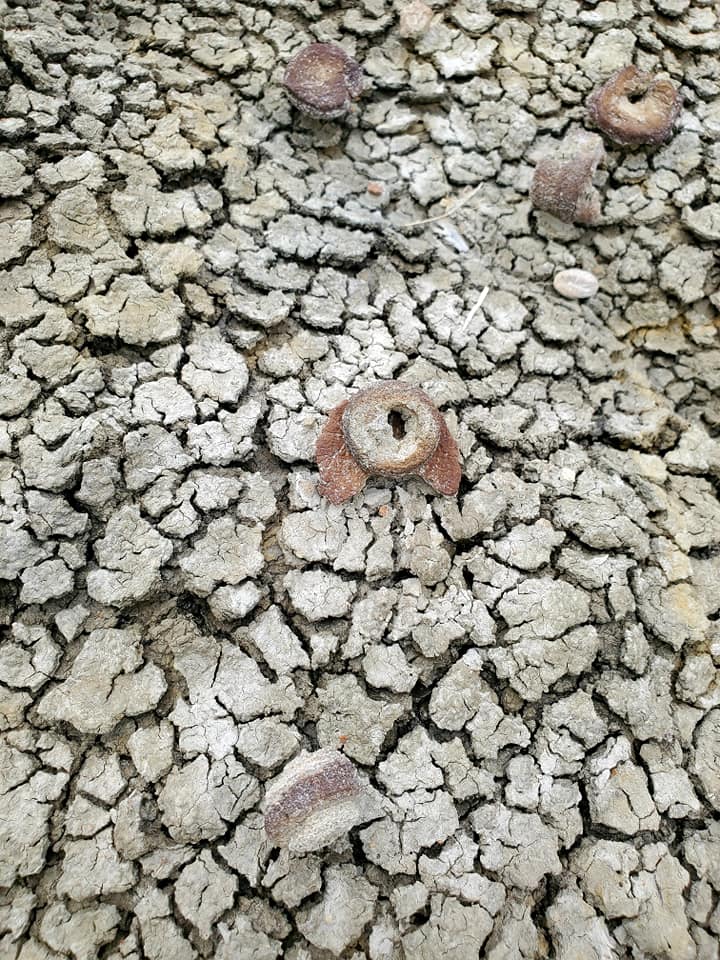Beyond Your Backyard - The Avonlea Badlands - A Trip 71 Million Years in the Making!"
By Kimberly J. Epp
On Saturday, August 24th, 29 participants headed out on a tour of the Avonlea Badlands.
The tour was provided by the Avonlea Heritage Museum, and organized by the Moose Jaw Nature Society.
The group on August 24th
Moose Jaw Nature Society tours and field trips provide a way to discover and learn more about nature while networking with other nature lovers.
The badlands are tucked away on private property near Avonlea. A deal was struck in 2013 with the Avonlea museum to provide guided tours, which has helped curb trespassers to this land. Some locals have never visited, and the area is a gem only a stones throw from Moose Jaw. The badlands are only accessible by foot, and the tour is a 2 kilometer hike. Hiking boots or good footwear are necessary.
The hike begins on a perfectly ordinary pasture, so one is surprised at how the landscape drastically changes as you walk on.
There are over 30 native flowers on site, along with native grasses and cacti species such as the Ball Cactus and the Prickly Pear Cactus.
Ball cactus with green berries on it after blooming - photo by Kimberly Epp
The Prickly Pear cactus was blooming, and blooms during a short 3 week period, usually in June or July - however we were lucky to catch it still blooming at the end of August.
The fruit of the cactus (following the flowering period) can be consumed, and even made into jam. Some people grow them in their greenhouses for this reason. The inside of the cactus plants contains water.
The Ball Cactus plants we saw were past their blooming period, and so had small green berries on many of them.
All of the flowers, cactus, hoodoos, possible fossils and more are for you to look at, but not to disturb.
We have only 12 per cent of our native grasslands remaining in this province, and this area is indeed a hidden gem you must see at least once in your lifetime.
Flowering prickly pear cactus. The flowering period is only three weeks long - photo by Shelley Zerr
As you walk, the guide stops to show the unique prairie plants and various formations along the way. Stone-capped hoodoos, weathered buttes, strange pillar formations and eroded cliffs soon come into view. At the top of the cliffs, some cattle decided to take in the show as well, likely finding the scrambling humans to be somewhat amusing.
Ball cactus - photo by Kimberly Epp
Erosion and glacial activity that occurred over millions of years has left a unique, almost alien landscape.
Sandstone with bentonite formation and various fault lines - photo by Shelley Zerr
In fact, during the Cretaceous period, a large inland sea covered the area. Later on, a 3 kilometer high glacier covered the area. This glacier scoured the surface. The meltwater caused further erosion. The area is more or less an ancient sea bed. The sedimentary layers that remain are amongst some of the most unique land forms in our province.
Possible fish vertebrae from the ancient inland sea - photo by Kimberly Epp
The area is still being eroded by wind, ice and rainwater. It is an ever-changing landscape.
One of the prominent hoodoos - photo by Kimberly Epp
There are two last chances for you to experience the badlands this year, one during a night photography class to photograph the milky way. This class is taking place on Saturday, August 31st - with instructor Colin Chatfield. Space is limited, so call and book as soon as possible.
There is also one last chance for a guided day hike, the morning of August 31st.
Contact the Avonlea Heritage Museum at (306) 868-2101 to confirm availability. Cost is $15/person with a group of less than 6, or $10/person with a larger group. Children cost $5.
Believe me, it is well worth the money!
Taking it all in - photo by Kimberly Epp
You will be experiencing an area few people have seen. If you cannot make the last tours, plan for the Spring season, when tours begin in mid-May, 2020. Saskatchewan has so much beauty, and it is up to you to discover it!
🌾🌾🌾🌾🌾🌾🌾🌾🌾🌾🌾🌾🌾🌾🌾
Epp is an Environmental Educator and writer and is also Past President and Field Trip Director for the Moose Jaw Nature Society (MJNS). She can be reached at kepp@shaw.ca.
If you are interested in learning more about the MJNS, the September meeting will be held September 27th at 6:30 pm in the basement of St. Mark's Church on 60 High St. E.
Guest speaker, Jan Shadick of Living Sky Wildlife Rehabilitation of Saskatoon, will be speaking. She will also bring some furry (and possibly feathery) animal ambassadors. See the MJNS Facebook page for more info.
"Moose Jaw Today" column on MJNS tours;
https://www.moosejawtoday.com/local-news/experience-all-the-nature-with-nature-society-field-trips-1642132
Well now that it is over I think I will rest for a minute or two - photo by Kimberly Epp









